仁爱英语八年级Unit7 Food Festival Topic 2 You must cook very carefully SectionB
文档属性
| 名称 | 仁爱英语八年级Unit7 Food Festival Topic 2 You must cook very carefully SectionB | 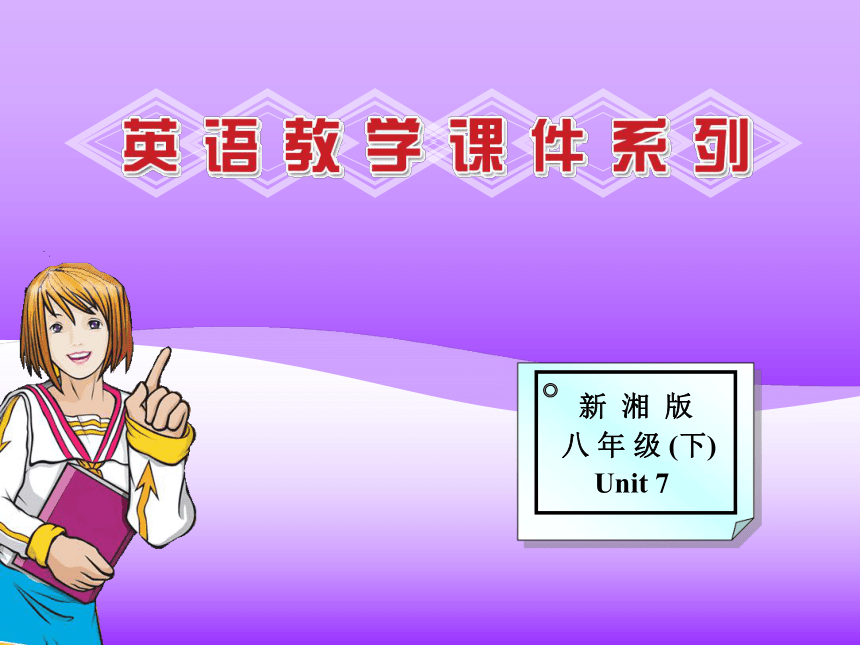 | |
| 格式 | rar | ||
| 文件大小 | 976.6KB | ||
| 资源类型 | 教案 | ||
| 版本资源 | 仁爱科普版 | ||
| 科目 | 英语 | ||
| 更新时间 | 2008-09-12 21:42:00 | ||
图片预览


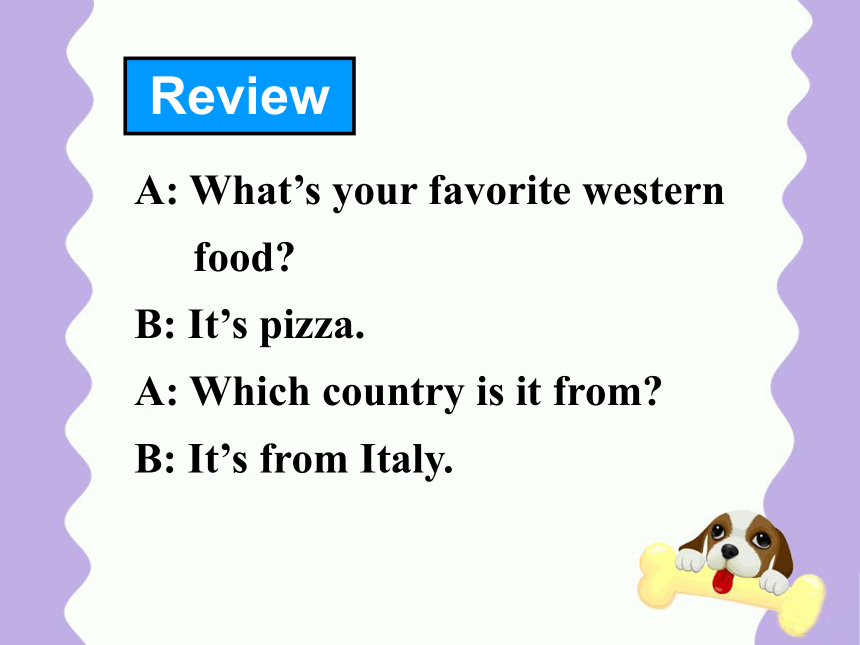


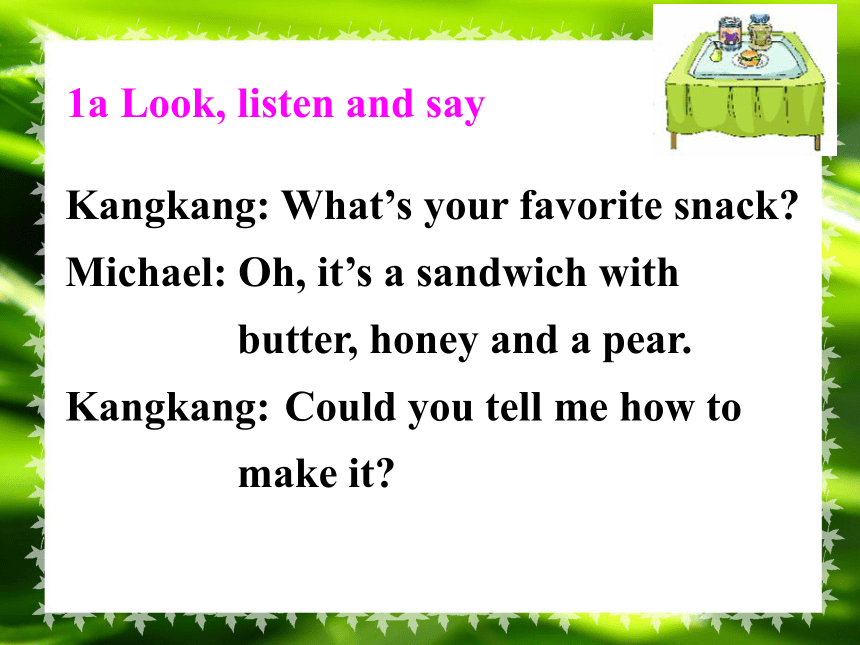
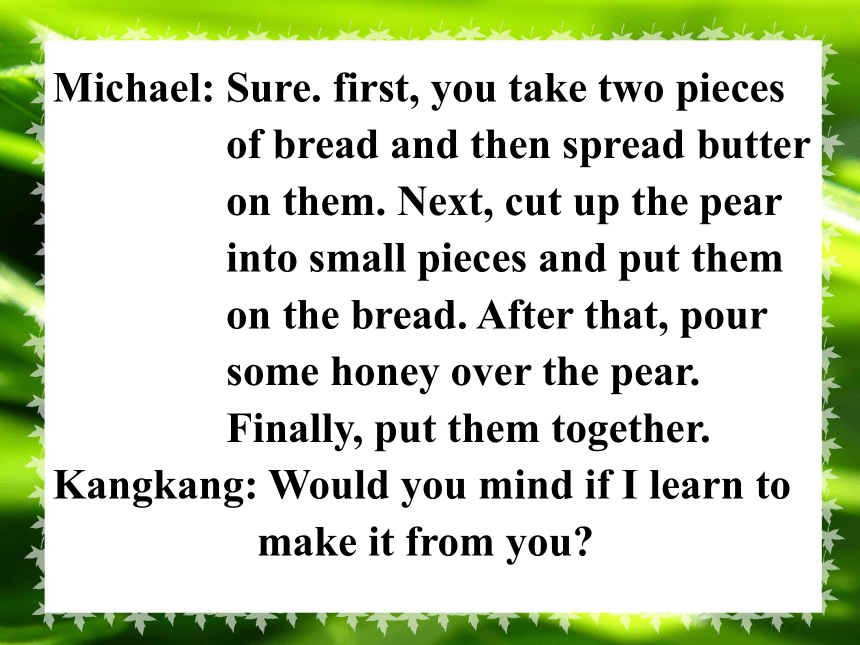
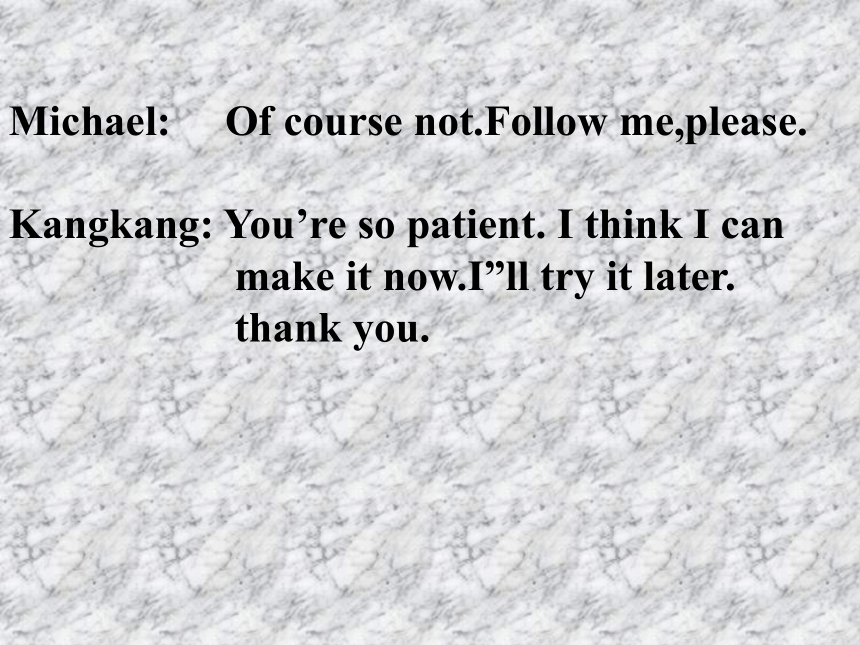
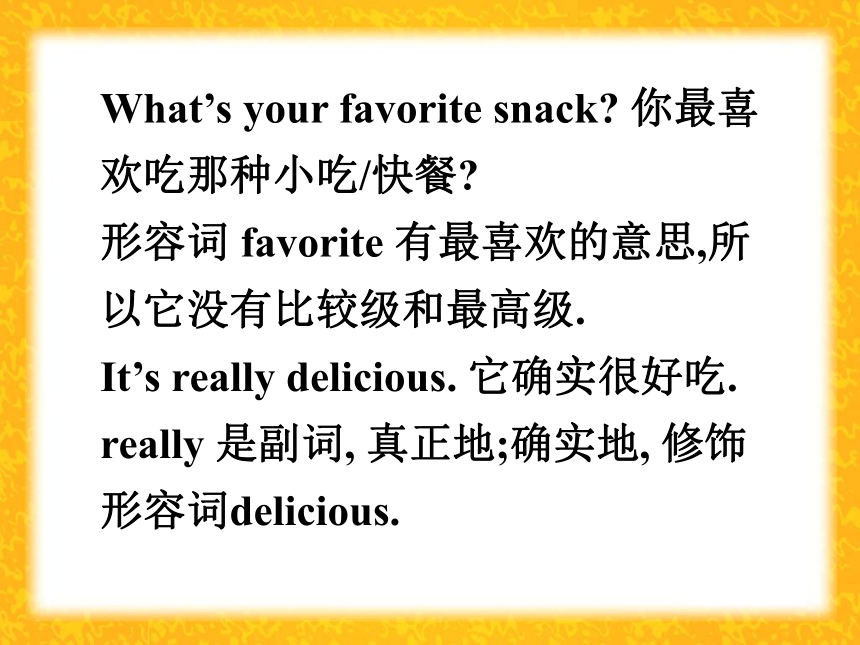
文档简介
课件28张PPT。 新 湘 版
八 年 级 (下)
Unit 7Unit 7 Topic 2
Section BReviewA: What’s your favorite western food?
B: It’s pizza.
A: Which country is it from?
B: It’s from Italy.First, take... and spread...
Next, cup up... and put...
After that, pour...
Finally, put...Kangkang: What’s your favorite snack?
Michael: Oh, it’s a sandwich with butter, honey and a pear.
Kangkang: Could you tell me how to make it?1a Look, listen and sayMichael: Sure. first, you take two pieces of bread and then spread butter on them. Next, cut up the pear into small pieces and put them on the bread. After that, pour some honey over the pear. Finally, put them together.
Kangkang: Would you mind if I learn to
make it from you?
Michael: Of course not.Follow me,please.
Kangkang: You’re so patient. I think I can
make it now.I”ll try it later.
thank you.
What’s your favorite snack? 你最喜欢吃那种小吃/快餐?
形容词 favorite 有最喜欢的意思,所以它没有比较级和最高级.
It’s really delicious. 它确实很好吃. really 是副词, 真正地;确实地, 修饰形容词delicious.
two pieces of bread 两片面包,bread 是不可数名词, 所以要表示一片面包的时候,不能说 a bread, 而要借助名词piece 来表达.spread butter on them. 在面包片上涂上黄油. spread 是动词 涂;敷的意思.
Cut up the pear into small slices把梨切成碎片. cut up … into…..把….切成… (一般是切成小碎片.)
比如: Please cut the meat into small slices , I will make some meat soup. 把肉切成小碎片, 我要熬点肉汤喝.First…. Next…. After that…. Finally……….
首先……接下来…..然后(那以后)….,最后(之后)…….这是一些表示先后顺序的词,大家要记下来,在今后的作文中可以使用. Now cover up the conversation. Can you remember how to make Michael’s unusual butter sandwich?1b Pair workFill in the blanks with the verbs.Add, Put, Cut, Heat1. ___ the bread into two halves.
2. ____ beef or fried chicken, cheese and lettuce to the bread.
3. ___ the two pieces of bread together.
4. ____ the bread for one minute. A hamburger is ready.CutAddPutHeat2. Work alone3a Listen, read and sayMaria: Come on , Ken! Help yourself to some soup.
Kumiko: OK. Mm, this soup is delicious. (slurp!)
Maria: Kumiko, is it too hot?
Kumiko : No, Why ?Maria: Well, in Cuba you shouldn’t eat so nosily.
Kumiko : Really? In Japan, it’s polite to do that. It means you like the food very much!
Maria: OK, let me try. (slurp!)
Ken: Not bad, Maria.Come on. 来吧.
---I’m sorry, I am afraid I can’t go swimming with you, because I have to finish my homework. (对不起, 恐怕我不能和你去游泳了。我得把家庭作业写完)。
---Come on! What a fine day today! (来吧! 你看今天的天气多好啊!)Help yourself to some soup. 你来点汤吧.这是主人让客人随便吃东西时说的一句话。
比如: Help yourself to some fruits. They are fresh. 请随便吃点水果,很新鲜的.It’s polite to do that. 那样做是很礼貌的.
be polite to do sth.干某事很有礼貌.
It is very polite to say “Good morning!” to people you meet in the morning. 早上遇见人的时候说 “早上好!”是有礼貌的表现.It means you like the food! 那说明你很喜欢这种食物.
It 代替的是 Eating noisily. 注意这里的means 是说明,表明的意思。
You like the food!是一个宾语从句, 做 means 的宾语.3. In pairs, discuss the questions below:
Is it polite to eat noisily or quietly in Cuba?
What about in Japan?
4. Listen to the tape in 3b and learn the different eating customs in different countries.3b Look, listen and say.It’s polite to eat soup noisily and finish all the rice in Japan.It’s impolite to eat with your arms or elbows on the table in American.Eat with your right hand in India. There’s no need of knife, fork ,spoon or chopsticks.People use a large spoon and a fork to eat in Thailand. They don’t use knives at all.It’s impolite to eat noisily in Cuba.It’s not impolite to smoke during a meal in France.4 Group work
Discuss how to eat politely in different countries in groups.
八 年 级 (下)
Unit 7Unit 7 Topic 2
Section BReviewA: What’s your favorite western food?
B: It’s pizza.
A: Which country is it from?
B: It’s from Italy.First, take... and spread...
Next, cup up... and put...
After that, pour...
Finally, put...Kangkang: What’s your favorite snack?
Michael: Oh, it’s a sandwich with butter, honey and a pear.
Kangkang: Could you tell me how to make it?1a Look, listen and sayMichael: Sure. first, you take two pieces of bread and then spread butter on them. Next, cut up the pear into small pieces and put them on the bread. After that, pour some honey over the pear. Finally, put them together.
Kangkang: Would you mind if I learn to
make it from you?
Michael: Of course not.Follow me,please.
Kangkang: You’re so patient. I think I can
make it now.I”ll try it later.
thank you.
What’s your favorite snack? 你最喜欢吃那种小吃/快餐?
形容词 favorite 有最喜欢的意思,所以它没有比较级和最高级.
It’s really delicious. 它确实很好吃. really 是副词, 真正地;确实地, 修饰形容词delicious.
two pieces of bread 两片面包,bread 是不可数名词, 所以要表示一片面包的时候,不能说 a bread, 而要借助名词piece 来表达.spread butter on them. 在面包片上涂上黄油. spread 是动词 涂;敷的意思.
Cut up the pear into small slices把梨切成碎片. cut up … into…..把….切成… (一般是切成小碎片.)
比如: Please cut the meat into small slices , I will make some meat soup. 把肉切成小碎片, 我要熬点肉汤喝.First…. Next…. After that…. Finally……….
首先……接下来…..然后(那以后)….,最后(之后)…….这是一些表示先后顺序的词,大家要记下来,在今后的作文中可以使用. Now cover up the conversation. Can you remember how to make Michael’s unusual butter sandwich?1b Pair workFill in the blanks with the verbs.Add, Put, Cut, Heat1. ___ the bread into two halves.
2. ____ beef or fried chicken, cheese and lettuce to the bread.
3. ___ the two pieces of bread together.
4. ____ the bread for one minute. A hamburger is ready.CutAddPutHeat2. Work alone3a Listen, read and sayMaria: Come on , Ken! Help yourself to some soup.
Kumiko: OK. Mm, this soup is delicious. (slurp!)
Maria: Kumiko, is it too hot?
Kumiko : No, Why ?Maria: Well, in Cuba you shouldn’t eat so nosily.
Kumiko : Really? In Japan, it’s polite to do that. It means you like the food very much!
Maria: OK, let me try. (slurp!)
Ken: Not bad, Maria.Come on. 来吧.
---I’m sorry, I am afraid I can’t go swimming with you, because I have to finish my homework. (对不起, 恐怕我不能和你去游泳了。我得把家庭作业写完)。
---Come on! What a fine day today! (来吧! 你看今天的天气多好啊!)Help yourself to some soup. 你来点汤吧.这是主人让客人随便吃东西时说的一句话。
比如: Help yourself to some fruits. They are fresh. 请随便吃点水果,很新鲜的.It’s polite to do that. 那样做是很礼貌的.
be polite to do sth.干某事很有礼貌.
It is very polite to say “Good morning!” to people you meet in the morning. 早上遇见人的时候说 “早上好!”是有礼貌的表现.It means you like the food! 那说明你很喜欢这种食物.
It 代替的是 Eating noisily. 注意这里的means 是说明,表明的意思。
You like the food!是一个宾语从句, 做 means 的宾语.3. In pairs, discuss the questions below:
Is it polite to eat noisily or quietly in Cuba?
What about in Japan?
4. Listen to the tape in 3b and learn the different eating customs in different countries.3b Look, listen and say.It’s polite to eat soup noisily and finish all the rice in Japan.It’s impolite to eat with your arms or elbows on the table in American.Eat with your right hand in India. There’s no need of knife, fork ,spoon or chopsticks.People use a large spoon and a fork to eat in Thailand. They don’t use knives at all.It’s impolite to eat noisily in Cuba.It’s not impolite to smoke during a meal in France.4 Group work
Discuss how to eat politely in different countries in groups.
同课章节目录
- Unit 5 Feeling excited
- Topic 1 You look excited
- Topic 2 I’m feeling better now.
- Topic 3 Many things can affect our feelings.
- Unit 6 Enjoying Cycling
- Topic 1 We're going on a three-day visit to Mount
- Topic 2 How about exploring Tian’anmen Square?
- Topic 3 Bicycle riding is good exercise.
- Unit 7 Food festival
- Topic 1 We’re preparing for a food festival.
- Topic 2 I’m not sure whether I can cook it well.
- Topic 3 I Cooked the Most Successfully
- Unit 8 Our Clothes
- Topic 1 We will have a class fashion show.
- Topic 2 We can design our own uniforms.
- Topic 3 He said the fashion show was wonderful.
